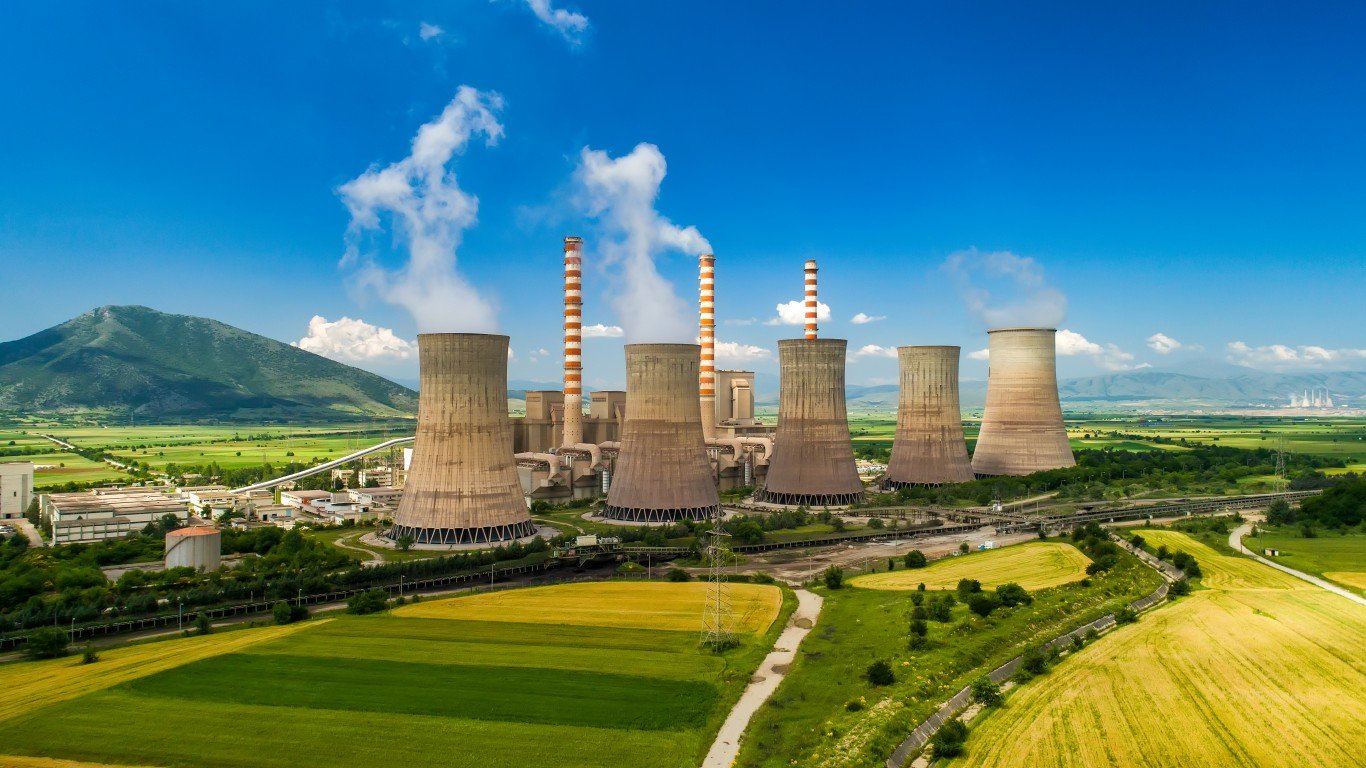

Nations around the world are answering the clarion call to cut greenhouse gas emissions in response to climate change.
At the United Nations Glasgow climate summit in November, nearly 200 nations agreed to speed up the fight against climate change and commit to stronger climate pledges. The United States and China — the world’s two largest emitters of greenhouse gasses — vowed to improve their cooperation on climate change, a similar commitment made at the Paris Agreement in 2015. Progress at the November summit also was reportedly made in areas of methane gas and deforestation.
As countries confront the challenge to the survival of the planet, some countries do a better job than others in reducing carbon emissions. (This country is the worst polluter in the world.)
To determine the 40 countries decreasing emissions the fastest, 24/7 Wall St. reviewed data from The Global Carbon Project, published annually by the Integrated Carbon Observation System, a community of more than 500 scientists, and from the International Energy Agency GHG Emissions from Energy 2021 Edition report. Countries are ranked by total CO2 emissions change from 2010 to 2020 using data from the Global Carbon Project.
Data on CO2 emissions change from 1971 to 2020 and total emissions by country are also from the Global Carbon Project. Data on change in CO2 emissions per capita and GHG emissions are from the IEA report.
Ever since the Paris Agreement, countries around the world have directed efforts to address the climate change threat. More than 200 countries agreed to limit GHG emissions to try and keep global warming below 2 degrees Celsius compared with temperatures before the Industrial Revolution.
Yet not everyone believes nations are moving fast enough. Climate scientists, legal experts, and politicians said agreements at the Glasgow conference did not go far enough to address the climate threat. Dissatisfaction with the pace of progress manifested itself in France, when a French court this past February convicted the French government of failing to show enough progress in meeting its legally binding emission reduction targets.
Countries on every continent except Australia are represented on the list of 40 as those that have reduced emissions the fastest from 2010 to 2020. More than half are European nations, many of whom are bound by GHG emission commitments tied to their membership to the European Union.
The continent with the next-most countries on the list is Asia with six, followed by North and South America with three each. (These are America’s 50 dirtiest cities.)
The United States, which returned to the Paris Agreement in February after President Joe Biden took office, managed to make the list of 40. As the world’s second largest polluter, however,the U.S. needs to do more. The world’s largest polluter, China, did not even make the list. China’s carbon emissions increased by nearly 24% from 2010 to 2020, and its GHG emissions by over 25%. (These are cities emitting the most carbon dioxide in the world.)
Click here to see the 40 countries emissions the fastest

40. United Arab Emirates
> Total CO2 emissions change 2010-2020: -16.81%
> Total CO2 emissions change 1971-2020: 609.92% — #43 largest increase of 145 countries
> Total CO2 emissions 2020 in million tons: 150.38 — #33 largest of 145
> CO2 emissions per capita change 2010-2019: 0.70% — #74 largest increase of 144
> Total GHG emissions change 2010-2019: 16.48% — #38 largest increase of 88
Even though the United Arab Emirates has made strides in reducing CO2 emissions, the World Health Organization still considers air quality in the nation on the Arabian Peninsula unsafe. The country’s stated goal is to reach net-zero emissions by 2050. The UAE said in a government report that it began financing clean energy projects about 15 years ago and has invested over $40 billion in the sector thus far.
[in-text-ad]

39. United States
> Total CO2 emissions change 2010-2020: -16.97%
> Total CO2 emissions change 1971-2020: 7.96% — #111 largest increase of 145 countries
> Total CO2 emissions 2020 in million tons: 4,716.20 — #2 largest of 145
> CO2 emissions per capita change 2010-2020: -24.86% — #33 largest decline of 144
> Total GHG emissions change 2010-2020: -16.91% — #17 largest decline of 88
The United States, one of the world’s biggest polluters, has rejoined the Paris Agreement under President Joe Biden. Former President Donald J. Trump had withdrawn the U.S. from the accord in 2017. The Biden Administration has said that the United States will aim to cut greenhouse gas emissions by 50% to 52% by 2030 from 2005 levels.

38. Israel
> Total CO2 emissions change 2010-2020: -17.48%
> Total CO2 emissions change 1971-2020: 247.44% — #66 largest increase of 145 countries
> Total CO2 emissions 2020 in million tons: 56.39 — #53 largest of 145
> CO2 emissions per capita change 2010-2020: -29.94% — #18 largest decline of 144
> Total GHG emissions change 2010-2020: -14.64% — #18 largest decline of 88
In July, the Israeli government set a goal for the nation to generate 85% less greenhouse gasses by 2050 than it did in 2015. The country also resolved to reach an interim target for 2030 of a 27% reduction in emissions.

37. Iceland
> Total CO2 emissions change 2010-2020: -19.00%
> Total CO2 emissions change 1971-2020: 99.43% — #85 largest increase of 145 countries
> Total CO2 emissions 2020 in million tons: 2.94 — #136 largest of 145
> CO2 emissions per capita change 2010-2020: -34.23% — #17 largest decline of 144
> Total GHG emissions change: No data
About 48% of Iceland’s carbon dioxide emissions are generated by heavy industry. The Nordic country has an interesting solution to disposing of CO2 — it takes captured carbon and injects it into rock and turns it into stone.
[in-text-ad-2]

36. Croatia
> Total CO2 emissions change 2010-2020: -19.21%
> Total CO2 emissions change 1971-2020: 46.67% — #99 largest increase of 145 countries
> Total CO2 emissions 2020 in million tons: 16.99 — #90 largest of 145
> CO2 emissions per capita change 2010-2020: -16.57% — #43 largest decline of 144
> Total GHG emissions change: No data
Although Croatia ranked among the top 40 countries in decreasing emissions the fastest, the Balkan nation has slipped in the Climate Change Performance Index for 2022. Croatia dropped 10 places from last year, scoring poorly in two of the four categories evaluated — GHG emissions and energy use. It did well in renewable energy and had some success in climate policy.

35. Singapore
> Total CO2 emissions change 2010-2020: -19.63%
> Total CO2 emissions change 1971-2020: 179.59% — #76 largest increase of 145 countries
> Total CO2 emissions 2020 in million tons: 45.54 — #57 largest of 145
> CO2 emissions per capita change 2010-2019: -0.57% — #65 largest decline of 144
> Total GHG emissions change: No data
After pledging to cut emissions by 16% by 2020 in 2009, in 2015 Singapore vowed to trim emissions by 36% from 2005 levels by 2030. The Asian city-state said in its Nationally Determined Contribution and Long-Term Low-Emissions Development Strategy report in 2020 that it hopes to achieve “net zero emissions as soon as viable in the second half of the century.”
[in-text-ad]
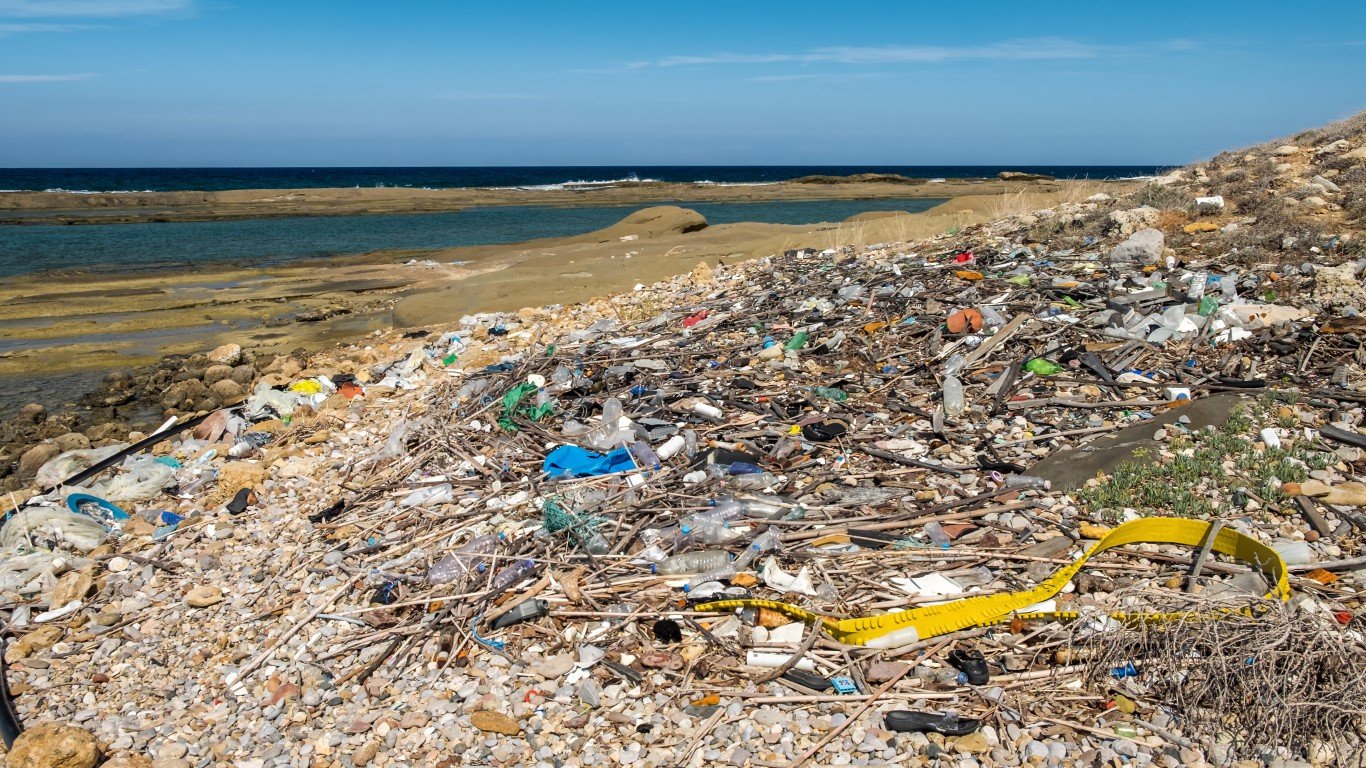
34. Cyprus
> Total CO2 emissions change 2010-2020: -19.80%
> Total CO2 emissions change 1971-2020: 244.89% — #67 largest increase of 145 countries
> Total CO2 emissions 2020 in million tons: 6.50 — #123 largest of 145
> CO2 emissions per capita change 2010-2020: -24.76% — #25 largest decline of 144
> Total GHG emissions change: No data
Cyprus has shown improvements in GHG emissions. However, published reports in January 2020 said the Mediterranean island nation was unable to meet its 2020 GHG emissions target, according to the European Commission. The commission also said Cyprus was going to miss its 2030 target by 25 percentage points. Electricity and transport are two sectors that generate the most emissions, the commission said.

33. Slovak Republic
> Total CO2 emissions change 2010-2020: -20.00%
> Total CO2 emissions change 1971-2020: -39.08% — #15 largest decline of 145 countries
> Total CO2 emissions 2020 in million tons: 30.75 — #75 largest of 145
> CO2 emissions per capita change 2010-2020: -23.78% — #35 largest decline of 144
> Total GHG emissions change: No data
The Slovak Republic’s fourth biennial report on GHG emissions said the central European nation has decreased its emissions by about 13% between 2008 and 2017.
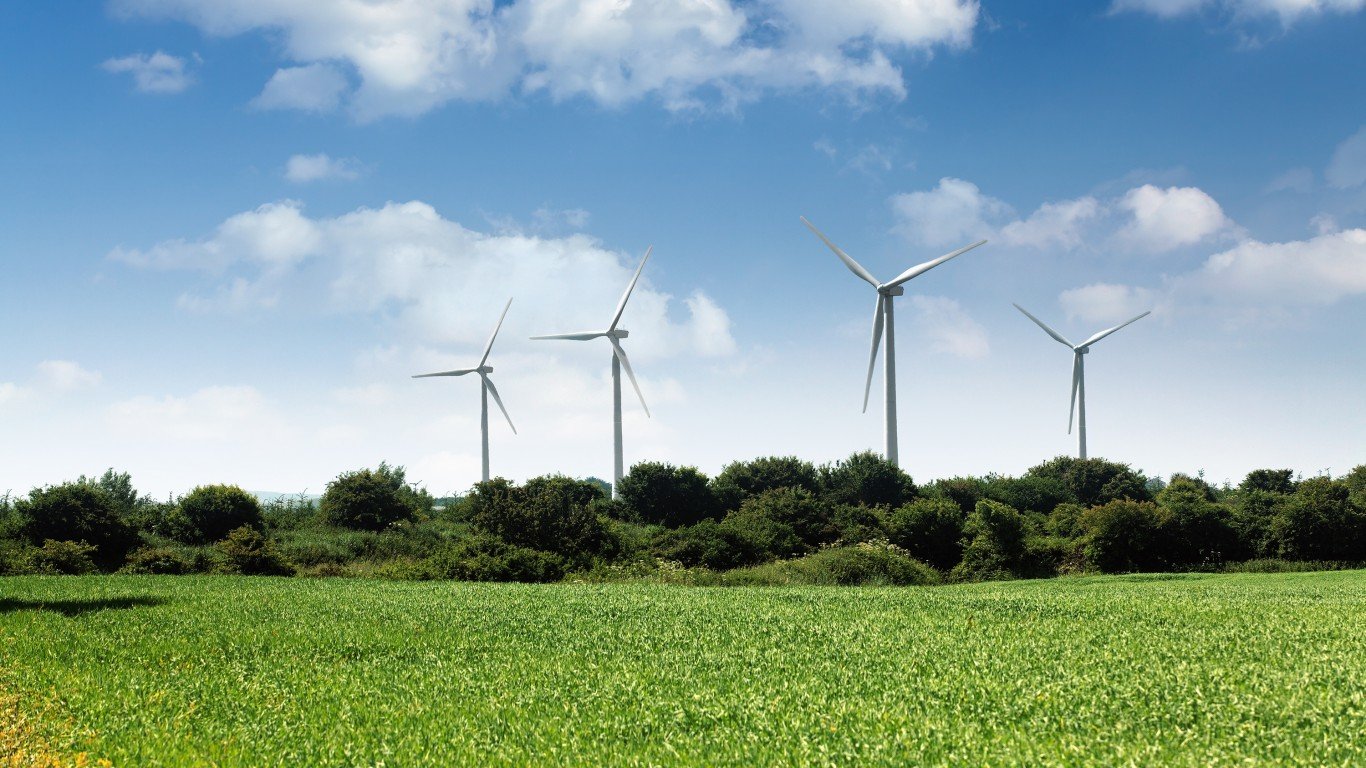
32. Ireland
> Total CO2 emissions change 2010-2020: -20.21%
> Total CO2 emissions change 1971-2020: 48.37% — #97 largest increase of 145 countries
> Total CO2 emissions 2020 in million tons: 33.37 — #71 largest of 145
> CO2 emissions per capita change 2010-2020: -25.90% — #24 largest decline of 144
> Total GHG emissions change: No data
As a member of the European Union, Ireland is committed to the EU’s overall GHG emissions targets. The island nation is aiming to cut emissions by 51% by 2030. The country wants to achieve a climate-neutral economy by 2050. Ireland’s plan to reduce air pollution is outlined in the Climate Action Plan 2021.
[in-text-ad-2]

31. Latvia
> Total CO2 emissions change 2010-2020: -20.83%
> Total CO2 emissions change 1971-2020: -59.36% — #4 largest decline of 145 countries
> Total CO2 emissions 2020 in million tons: 6.78 — #118 largest of 145
> CO2 emissions per capita change 2010-2020: -13.09% — #54 largest decline of 144
> Total GHG emissions change: No data
The Baltic nation’s transport ministry has set a goal for the transportation sector to cut GHG emissions by 18% by 2023 and by 23% by 2027. There are doubts Latvia can meet those goals, given that 86% of its road transport are private vehicles. The nation is also getting inundated with diesel vehicles from nations looking to shift to greener transportation options.

30. Bulgaria
> Total CO2 emissions change 2010-2020: -21.76%
> Total CO2 emissions change 1971-2020: -41.70% — #14 largest decline of 145 countries
> Total CO2 emissions 2020 in million tons: 37.47 — #65 largest of 145
> CO2 emissions per capita change 2010-2020: -16.50% — #47 largest decline of 144
> Total GHG emissions change: No data
Two years ago, Bulgaria pledged to update its target for renewable energy. It lifted the portion of wind, solar, and other renewables to 27% from 25% of its energy consumption it aims to achieve by 2030. The Balkan nation is relying more on hydropower for its energy needs.
[in-text-ad]

29. Peru
> Total CO2 emissions change 2010-2020: -21.81%
> Total CO2 emissions change 1971-2020: 140.48% — #81 largest increase of 145 countries
> Total CO2 emissions 2020 in million tons: 44.74 — #58 largest of 145
> CO2 emissions per capita change 2010-2019: 12.23% — #48 largest increase of 144
> Total GHG emissions change 2010-2019: 25.20% — #31 largest increase of 88
Peru’s goal is to be carbon neutral by 2030. To do this, the government has enacted an aggressive monitoring system for emissions that assigns levels of GHG utilization.
28. Hong Kong, China
> Total CO2 emissions change 2010-2020: -22.03%
> Total CO2 emissions change 1971-2020: 241.39% — #69 largest increase of 145 countries
> Total CO2 emissions 2020 in million tons: 31.26 — #73 largest of 145
> CO2 emissions per capita change 2010-2020: -20.45% — #56 largest decline of 144
> Total GHG emissions change: No data
Hong Kong aims to be carbon neutral by 2050. Its carbon emissions are mostly from power generation and vehicular traffic. The city is a special administrative region of the People’s Republic of China.
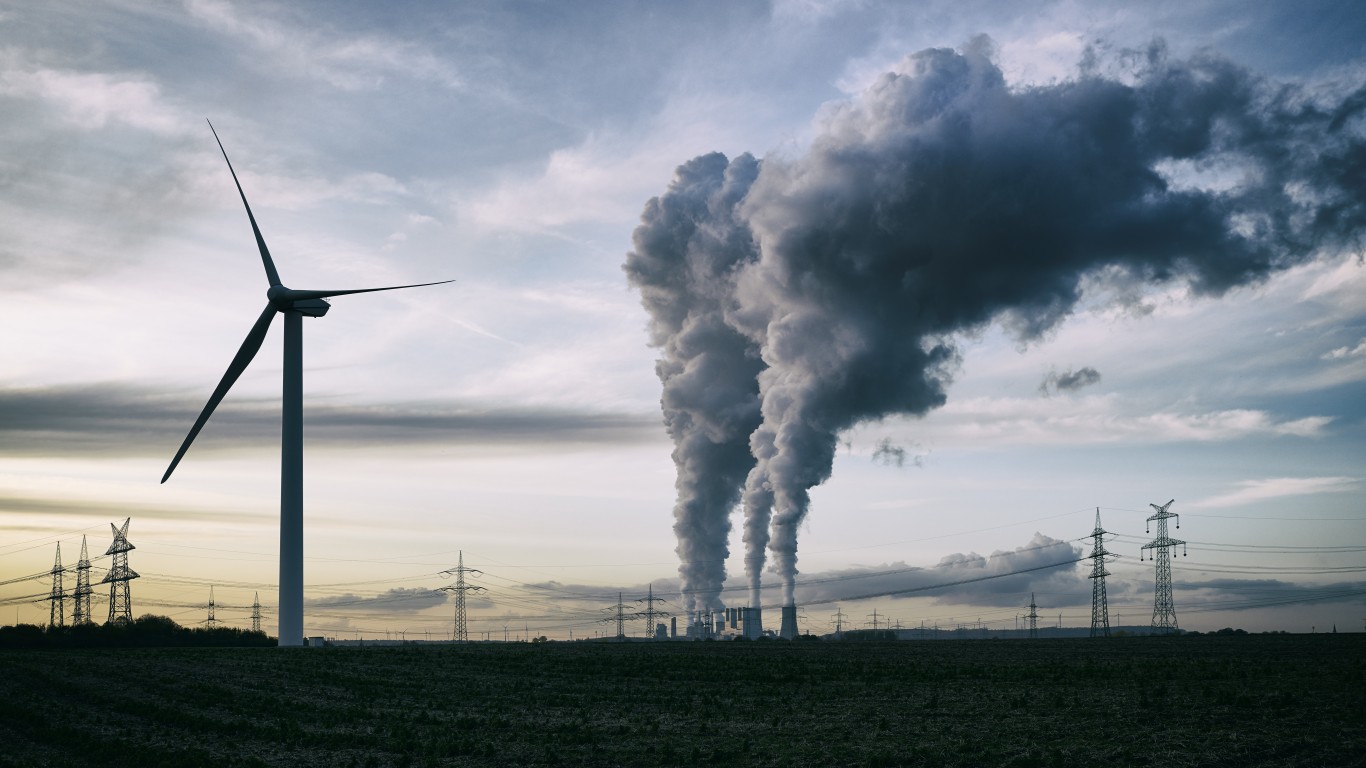
27. Germany
> Total CO2 emissions change 2010-2020: -22.65%
> Total CO2 emissions change 1971-2020: -37.88% — #17 largest decline of 145 countries
> Total CO2 emissions 2020 in million tons: 644.78 — #7 largest of 145
> CO2 emissions per capita change 2010-2020: -25.54% — #27 largest decline of 144
> Total GHG emissions change 2010-2020: -22.90% — #13 largest decline of 88
Germany’s goal is to be GHG neutral by 2050. Europe’s largest economy and most populous nation aims to slash emissions by at least 65% by 2030 from 1990 levels.
[in-text-ad-2]

26. Mexico
> Total CO2 emissions change 2010-2020: -23.03%
> Total CO2 emissions change 1971-2020: 182.89% — #75 largest increase of 145 countries
> Total CO2 emissions 2020 in million tons: 357.23 — #16 largest of 145
> CO2 emissions per capita change 2010-2020: -22.25% — #39 largest decline of 144
> Total GHG emissions change 2010-2020: -12.49% — #20 largest decline of 88
In December 2020, Mexico committed to cutting its emissions by 22% to 36% by 2030. Those are the same targets the nation committed to in its original nationally determined contribution in 2016.

25. Angola
> Total CO2 emissions change 2010-2020: -23.10%
> Total CO2 emissions change 1971-2020: 551.86% — #49 largest increase of 145 countries
> Total CO2 emissions 2020 in million tons: 22.21 — #83 largest of 145
> CO2 emissions per capita change 2010-2019: -3.59% — #57 largest decline of 144
> Total GHG emissions change 2010-2019: -3.93% — #30 largest decline of 88
Angola said it will reduce GHG emissions by up to 35% by 2030. The southwestern African nation, the continent’s seventh biggest and 12th-most populous, accounts for about 0.36% of global emissions, according to the World Resources Institute.
[in-text-ad]

24. Slovenia
> Total CO2 emissions change 2010-2020: -23.54%
> Total CO2 emissions change 1971-2020: 32.73% — #103 largest increase of 145 countries
> Total CO2 emissions 2020 in million tons: 12.57 — #97 largest of 145
> CO2 emissions per capita change 2010-2020: No data
> Total GHG emissions change 2010-2020: -23.49% — #12 largest decline of 88
Slovenia’s total GHG emissions declined the 12th most from 2010 to 2020. The Balkan nation aims to be carbon neutral by 2050. Its infrastructure ministry said in 2020 that it planned to reduce emissions by at least 36% by 2030 compared to 2005.

23. Portugal
> Total CO2 emissions change 2010-2020: -23.82%
> Total CO2 emissions change 1971-2020: 146.63% — #79 largest increase of 145 countries
> Total CO2 emissions 2020 in million tons: 40.42 — #61 largest of 145
> CO2 emissions per capita change 2010-2020: -19.41% — #46 largest decline of 144
> Total GHG emissions change: No data
Portugal’s National Energy and Climate Plan set a 2030 target of 45% to 55% reduction in total GHG emissions compared with 2005. The country has made a major effort to fast-track construction of energy efficient buildings through public and private investment until 2050.

22. Netherlands
> Total CO2 emissions change 2010-2020: -23.93%
> Total CO2 emissions change 1971-2020: -1.82% — #28 largest decline of 145 countries
> Total CO2 emissions 2020 in million tons: 138.20 — #34 largest of 145
> CO2 emissions per capita change 2010-2020: -24.85% — #28 largest decline of 144
> Total GHG emissions change 2010-2020: -20.96% — #14 largest decline of 88
The Netherlands plans to cut Dutch GHG emissions by 49% by 2030, compared with 1990 levels, and by 95% by 2050.
[in-text-ad-2]

21. Trinidad and Tobago
> Total CO2 emissions change 2010-2020: -24.38%
> Total CO2 emissions change 1971-2020: 338.58% — #59 largest increase of 145 countries
> Total CO2 emissions 2020 in million tons: 35.54 — #67 largest of 145
> CO2 emissions per capita change 2010-2019: -24.75% — #19 largest decline of 144
> Total GHG emissions change 2010-2019: -19.48% — #16 largest decline of 88
Trinidad and Tobago has been one of the more successful Caribbean nations in reducing emissions. The island country has committed to a 30% reduction of carbon emissions in the public transport sector by 2030.
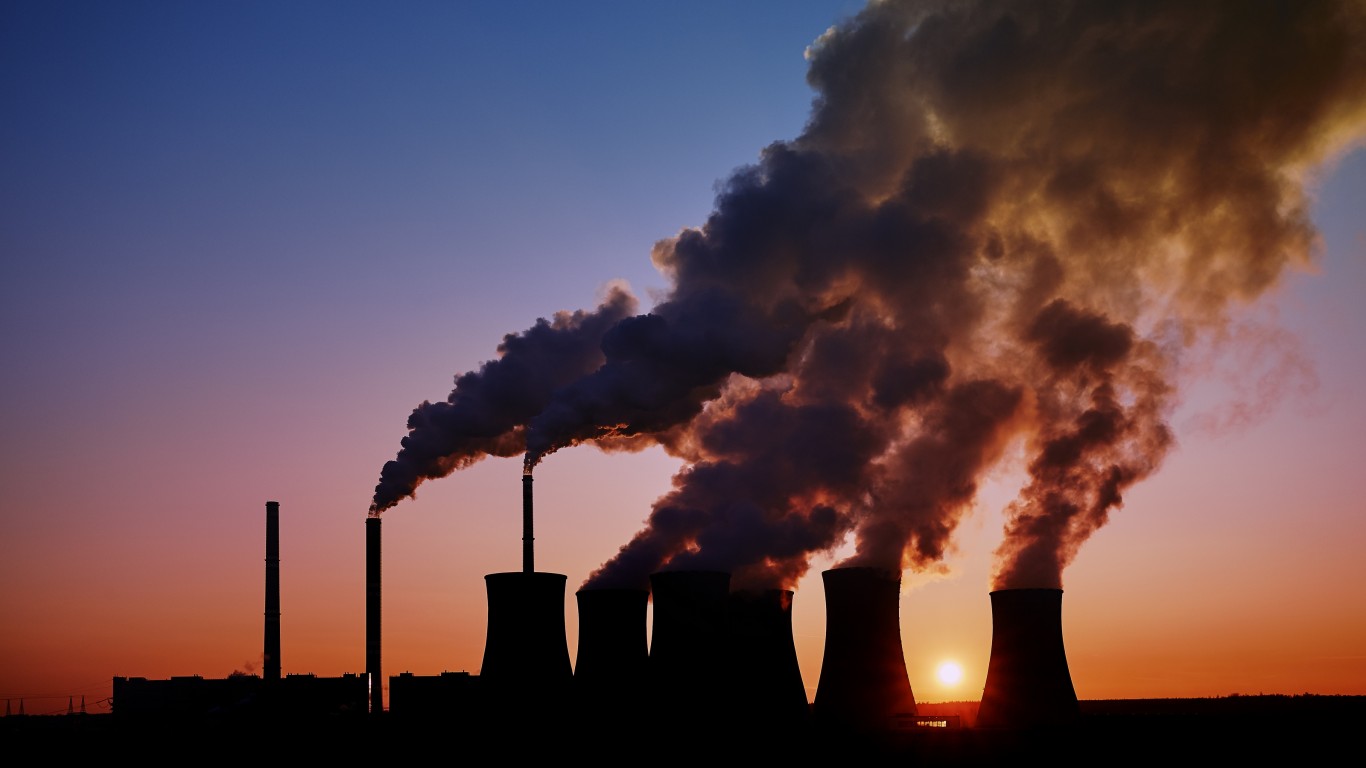
20. Czech Republic
> Total CO2 emissions change 2010-2020: -25.19%
> Total CO2 emissions change 1971-2020: -44.79% — #11 largest decline of 145 countries
> Total CO2 emissions 2020 in million tons: 88.04 — #43 largest of 145
> CO2 emissions per capita change 2010-2020: -25.17% — #34 largest decline of 144
> Total GHG emissions change: No data
The Czech Republic has succeeded in creating and utilizing renewable sources of energy. However, industrial pollution is still an issue in the Central European country. The European Commission is urging the Czech Republic to reduce the use of diesel-powered vehicles in cities such as Prague, Brno, and Ostrava.
[in-text-ad]

19. Spain
> Total CO2 emissions change 2010-2020: -26.41%
> Total CO2 emissions change 1971-2020: 62.63% — #93 largest increase of 145 countries
> Total CO2 emissions 2020 in million tons: 209.07 — #30 largest of 145
> CO2 emissions per capita change 2010-2020: -26.90% — #41 largest decline of 144
> Total GHG emissions change: No data
Spain, which accounts for 9% of the European Union’s total GHG emissions, is proposing to cut its carbon emissions to net zero by 2050. Between 2005 and 2019, Spain cut emissions by 27%, better than the EU average.

18. France
> Total CO2 emissions change 2010-2020: -26.54%
> Total CO2 emissions change 1971-2020: -43.79% — #12 largest decline of 145 countries
> Total CO2 emissions 2020 in million tons: 276.84 — #21 largest of 145
> CO2 emissions per capita change 2010-2020: -27.03% — #32 largest decline of 144
> Total GHG emissions change 2010-2020: -23.81% — #11 largest decline of 88
France, one of the first European countries to pass a carbon neutrality law, has a national law aiming to slash emissions by 40% by 2030 compared with 1990 levels. The French plan to do this is by shutting the country’s remaining coal plants by 2022. Despite its intentions, some in France believe the government is not doing enough. This past February, a French court convicted the French government of failing to show enough progress in meeting its legally binding emission reduction targets.
17. Belgium
> Total CO2 emissions change 2010-2020: -26.88%
> Total CO2 emissions change 1971-2020: -31.00% — #18 largest decline of 145 countries
> Total CO2 emissions 2020 in million tons: 83.81 — #45 largest of 145
> CO2 emissions per capita change 2010-2020: -24.43% — #29 largest decline of 144
> Total GHG emissions change: No data
Belgium accounts for just 3.3% of the total EU GHG emissions. It has reduced emissions at a slower pace than the EU average since 2005, according to a European Parliament report.
[in-text-ad-2]
16. Luxembourg
> Total CO2 emissions change 2010-2020: -27.06%
> Total CO2 emissions change 1971-2020: -38.04% — #16 largest decline of 145 countries
> Total CO2 emissions 2020 in million tons: 8.18 — #111 largest of 145
> CO2 emissions per capita change 2010-2020: -43.50% — #14 largest decline of 144
> Total GHG emissions change: No data
The tiny country of Luxembourg, which produces 0.34% of the EU’s total GHG output, hopes to slash emissions by up to 55% by 2030 compared with 2005. In Luxembourg, almost half of all emissions are tied to transportation, and transport emissions have been reduced by 14% since 2005.

15. Ukraine
> Total CO2 emissions change 2010-2020: -27.26%
> Total CO2 emissions change 1971-2020: -55.75% — #6 largest decline of 145 countries
> Total CO2 emissions 2020 in million tons: 214.06 — #27 largest of 145
> CO2 emissions per capita change 2010-2020: -45.17% — #11 largest decline of 144
> Total GHG emissions change 2010-2020: -38.64% — #5 largest decline of 88
Ukraine had the fifth-biggest total GHG emissions reduction from 2010 to 2020 and the sixth-largest drop of total CO2 emissions from 1971 to 2020. At the COP26 climate summit in Glasgow in November, President Volodymyr Zelensky said Ukraine’s goal is to reduce GHG emissions by 65% ââby 2030 and reach climate neutrality by 2060.
[in-text-ad]

14. Sweden
> Total CO2 emissions change 2010-2020: -27.28%
> Total CO2 emissions change 1971-2020: -54.28% — #7 largest decline of 145 countries
> Total CO2 emissions 2020 in million tons: 38.66 — #63 largest of 145
> CO2 emissions per capita change 2010-2020: -37.81% — #10 largest decline of 144
> Total GHG emissions change 2010-2020: -29.92% — #9 largest decline of 88
Sweden was among the top 10 nations in total CO2 emissions reductions from 1971 to 2020, CO2 emissions per capita from 2010 to 2020, and total GHG emissions from 2010 to 2020. Sweden has committed to cutting its net carbon emissions to zero by 2045, lifting its carbon emissions target since the Paris Agreement in 2015.

13. Switzerland
> Total CO2 emissions change 2010-2020: -28.30%
> Total CO2 emissions change 1971-2020: -22.89% — #20 largest decline of 145 countries
> Total CO2 emissions 2020 in million tons: 32.32 — #72 largest of 145
> CO2 emissions per capita change 2010-2020: -28.47% — #20 largest decline of 144
> Total GHG emissions change: No data
Earlier this month, Switzerland offered new legislation to halve GHG emissions by 2030 via a carbon dioxide tax. It did not include levies on air flights and car fuel in the legislation. Voters in June rejected government carbon-tax plans.

12. Italy
> Total CO2 emissions change 2010-2020: -30.34%
> Total CO2 emissions change 1971-2020: -2.33% — #27 largest decline of 145 countries
> Total CO2 emissions 2020 in million tons: 304.04 — #18 largest of 145
> CO2 emissions per capita change 2010-2020: -28.74% — #21 largest decline of 144
> Total GHG emissions change 2010-2020: -28.12% — #10 largest decline of 88
Italy cracked the top 10 in total GHG emissions reduction from 2010 to 2020. As a member of the European Union, Italy’s emissions goals are connected with those of the EU. The EU recently introduced new guidelines on cutting emissions by at least 55% by 2030 from 1990 levels.
[in-text-ad-2]
11. United Kingdom
> Total CO2 emissions change 2010-2020: -35.58%
> Total CO2 emissions change 1971-2020: -50.09% — #9 largest decline of 145 countries
> Total CO2 emissions 2020 in million tons: 329.82 — #17 largest of 145
> CO2 emissions per capita change 2010-2020: -39.97% — #12 largest decline of 144
> Total GHG emissions change 2010-2020: -35.13% — #7 largest decline of 88
The United Kingdom, birthplace of the Industrial Revolution, posted the seventh-largest decline in total GHG emissions from 2010 to 2020, and the ninth-biggest reduction of total CO2 emissions from 1971 to 2020. In April, the U.K. government said it intends to slash emissions by 78% compared with 1990 levels and is aiming to reach net zero by 2050.

10. Malta
> Total CO2 emissions change 2010-2020: -38.17%
> Total CO2 emissions change 1971-2020: 141.83% — #80 largest increase of 145 countries
> Total CO2 emissions 2020 in million tons: 1.60 — #143 largest of 145
> CO2 emissions per capita change 2010-2020: -51.87% — #4 largest decline of 144
> Total GHG emissions change: No data
Malta had the fourth-biggest drop in total CO2 emissions per capita from 2010 to 2020. The Mediterranean nation forecasts the biggest reduction in carbon emissions will take place between 2030 and 2040.
[in-text-ad]

9. Finland
> Total CO2 emissions change 2010-2020: -38.71%
> Total CO2 emissions change 1971-2020: -3.08% — #25 largest decline of 145 countries
> Total CO2 emissions 2020 in million tons: 39.32 — #62 largest of 145
> CO2 emissions per capita change 2010-2020: -44.17% — #9 largest decline of 144
> Total GHG emissions change: No data
Finland posted the ninth-largest decline in CO2 emission per capita from 2010 to 2020. The Scandinavian nation was one of the first to enact a carbon tax policy that has been successful in cutting carbon dioxide emissions.

8. Cuba
> Total CO2 emissions change 2010-2020: -41.07%
> Total CO2 emissions change 1971-2020: 2.88% — #115 largest increase of 145 countries
> Total CO2 emissions 2020 in million tons: 20.17 — #87 largest of 145
> CO2 emissions per capita change 2010-2019: -7.96% — #48 largest decline of 144
> Total GHG emissions change 2010-2019: -7.58% — #28 largest decline of 88
Cuba has indicated in recent years it is open to selling carbon credits on the international market, an idea that is at odds with its socialist philosophy. In 2019, Cuba approved a new constitution that included amendments directing the island nation to “promote the conservation of the environment and the fight against climate change, which threatens the survival of the human species.”
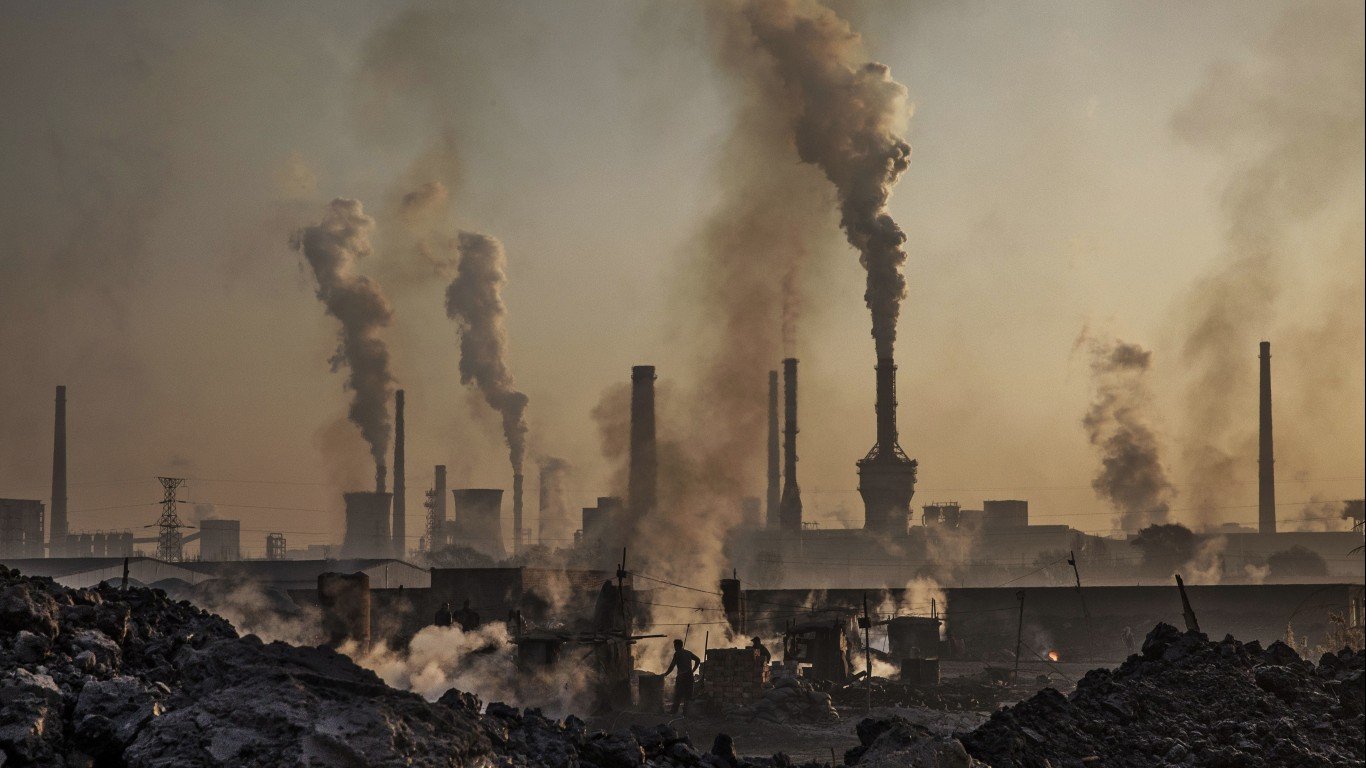
7. DPR of Korea
> Total CO2 emissions change 2010-2020: -41.40%
> Total CO2 emissions change 1971-2020: -72.72% — #2 largest decline of 145 countries
> Total CO2 emissions 2020 in million tons: 29.33 — #77 largest of 145
> CO2 emissions per capita change 2010-2019: 3.64% — #61 largest increase of 144
> Total GHG emissions change: No data
The Democratic People’s Republic of Korea, or North Korea, recorded the second-biggest reduction in total CO2 emission from 1971 to 2020. According to the UN, the nation’s sustainable development goals “are a global call to action to end poverty, protect the earth’s environment and climate, and ensure that people everywhere can enjoy peace and prosperity.”
[in-text-ad-2]

6. Estonia
> Total CO2 emissions change 2010-2020: -44.97%
> Total CO2 emissions change 1971-2020: -58.53% — #5 largest decline of 145 countries
> Total CO2 emissions 2020 in million tons: 10.46 — #102 largest of 145
> CO2 emissions per capita change 2010-2020: -53.82% — #5 largest decline of 144
> Total GHG emissions change 2010-2020: -52.12% — #3 largest decline of 88
Estonia posted the third-biggest decline in total GHG emissions from 2010 to 2020 and fifth-largest reduction in CO2 emissions over the same period. The Baltic country’s goal is to slash transport sector emissions by as much as 38% by 2025 from 2018 levels.

5. Greece
> Total CO2 emissions change 2010-2020: -46.35%
> Total CO2 emissions change 1971-2020: 88.24% — #86 largest increase of 145 countries
> Total CO2 emissions 2020 in million tons: 52.27 — #54 largest of 145
> CO2 emissions per capita change 2010-2020: -41.96% — #15 largest decline of 144
> Total GHG emissions change: No data
The government of Greece in November introduced climate change legislation that included ending the sale of cars running on fuel or diesel by 2030 and banning the use of heating oil.
[in-text-ad]

4. Denmark
> Total CO2 emissions change 2010-2020: -46.73%
> Total CO2 emissions change 1971-2020: -54.05% — #8 largest decline of 145 countries
> Total CO2 emissions 2020 in million tons: 26.21 — #80 largest of 145
> CO2 emissions per capita change 2010-2020: -48.53% — #7 largest decline of 144
> Total GHG emissions change 2010-2020: -45.41% — #4 largest decline of 88
Denmark boasted the fourth-largest drop in GHG emissions from 2010 to 2020. The Scandinavian nation has vowed to cut emissions by 70% by 2030 from 1990 levels. That translates to an annual CO2 emissions reduction by 20 million tons.

3. Syrian Arab Republic
> Total CO2 emissions change 2010-2020: -49.71%
> Total CO2 emissions change 1971-2020: 244.05% — #68 largest increase of 145 countries
> Total CO2 emissions 2020 in million tons: 30.55 — #76 largest of 145
> CO2 emissions per capita change 2010-2019: -48.45% — #3 largest decline of 144
> Total GHG emissions change 2010-2019: -62.23% — #2 largest decline of 88
The Syrian Arab Republic registered the second-largest decline in GHG emissions and the third biggest drop of CO2 emissions per capita of the 144 countries with data.

2. Venezuela
> Total CO2 emissions change 2010-2020: -54.04%
> Total CO2 emissions change 1971-2020: 35.37% — #100 largest increase of 145 countries
> Total CO2 emissions 2020 in million tons: 84.67 — #44 largest of 145
> CO2 emissions per capita change 2010-2019: -42.25% — #8 largest decline of 144
> Total GHG emissions change 2010-2019: -37.02% — #6 largest decline of 88
Venezuela slashed GHG emissions by 37% from 2010 to 2019, the sixth-biggest drop of any country on the list. The worldwide decarbonization effort could mean Venezuela — which has the world’s largest oil reserves — will have the world’s biggest stranded asset.
[in-text-ad-2]
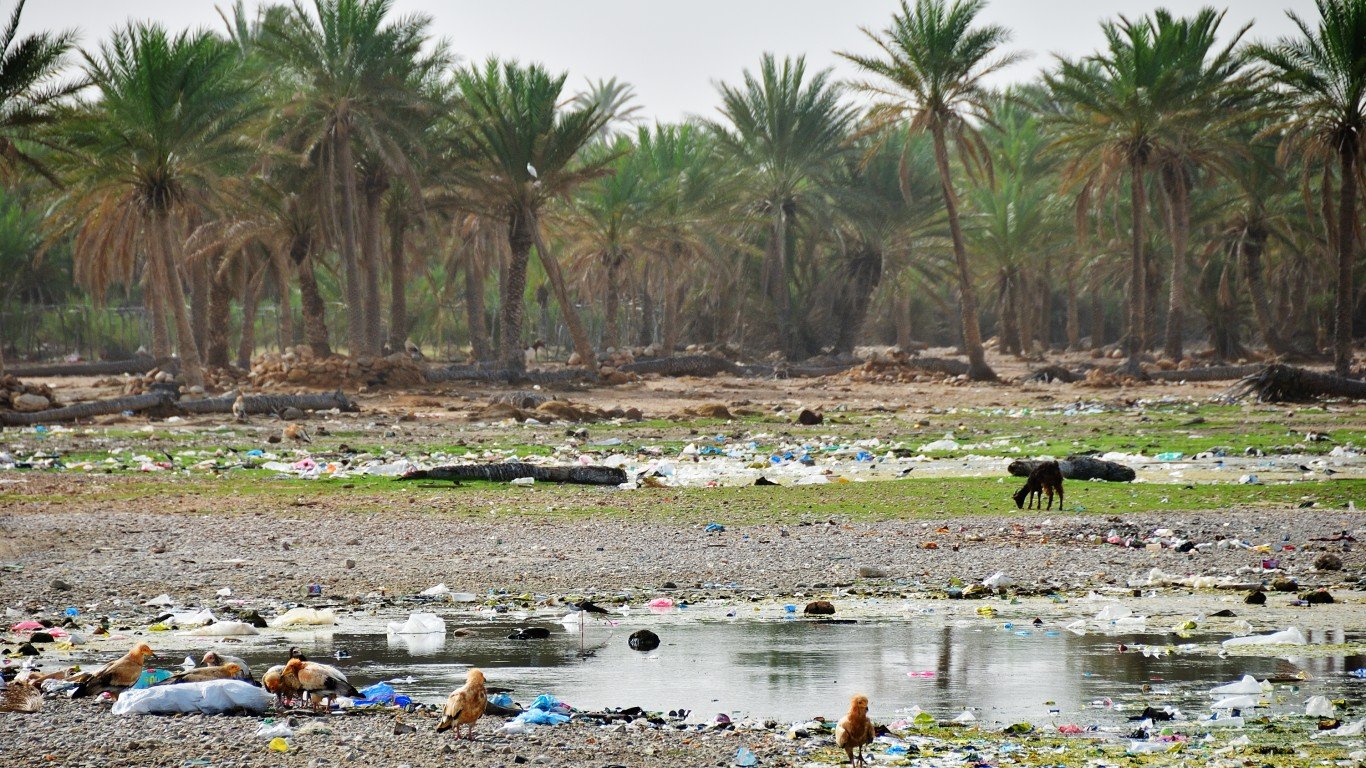
1. Yemen
> Total CO2 emissions change 2010-2020: -57.81%
> Total CO2 emissions change 1971-2020: 395.54% — #51 largest increase of 145 countries
> Total CO2 emissions 2020 in million tons: 9.78 — #108 largest of 145
> CO2 emissions per capita change 2010-2019: -65.98% — #1 largest decline of 144
> Total GHG emissions change 2010-2019: -66.52% — #1 largest decline of 88
Yemen tops the list of countries that are decreasing emissions the fastest. The nation on the Arabian Peninsula led all nations (145 with data) in percentage of emissions reduction for greenhouse gasses and for CO2.
Essential Tips for Investing: Sponsored
A financial advisor can help you understand the advantages and disadvantages of investment properties. Finding a qualified financial advisor doesn’t have to be hard. SmartAsset’s free tool matches you with up to three financial advisors who serve your area, and you can interview your advisor matches at no cost to decide which one is right for you. If you’re ready to find an advisor who can help you achieve your financial goals, get started now.
Investing in real estate can diversify your portfolio. But expanding your horizons may add additional costs. If you’re an investor looking to minimize expenses, consider checking out online brokerages. They often offer low investment fees, helping you maximize your profit.
Thank you for reading! Have some feedback for us?
Contact the 24/7 Wall St. editorial team.
 24/7 Wall St.
24/7 Wall St. 24/7 Wall St.
24/7 Wall St.


 24/7 Wall St.
24/7 Wall St.



